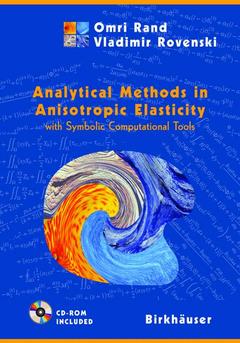Analytical Methods in Anisotropic Elasticity, 2005 with Symbolic Computational Tools
Auteurs : Rand Omri, Rovenski Vladimir

Omri Rand is a Professor of Aerospace Engineering at the Technion – Israel Institute of Technology. He has been involved in research on theoretical modeling and analysis in the area of anisotropic elasticity for the last fifteen years, he is the author of many journal papers and conference presentations in this area. Dr. Rand has been extensively active in composite rotor blade analysis, and established many well recognized analytical and numerical approaches. He teaches graduate courses in the area of anisotropic elasticity, serves as the Editor-in-Chief of Science and Engineering of Composite Materials, as a reviewer for leading professional journals, and as a consultant to various research and development organizations.
Vladimir Rovenski is a Professor of Mathematics and a well known researcher in the area of Riemannian and computational geometry. He is a corresponding member of the Natural Science Academy of Russia, a member of the American Mathematical Society, and serves as a reviewer of Zentralblatt für Mathematik. He is the author of many journal papers and books, including Foliations on Riemannian Manifolds and Submanifolds (Birkhäuser, 1997), and Geometry of Curves and Surfaces with MAPLE (Birkhäuser, 2000). Since 1999, Dr. Rovenski is a senior scientist at the faculty of Aerospace Engineering at the Technion – Israel Institute of Technology, and a lecturer at Haifa University.
Date de parution : 10-2004
Ouvrage de 451 p.
17.8x25.4 cm
